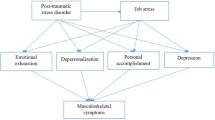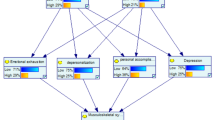Abstract
Prior research has suggested that occupational stressors may contribute to the etiology, progression, and chronicity of pain problems in workers. This study used anonymous survey methods to assess the prevalence and frequency of self-reported pain symptoms and their relationships to demographic variables, sources of occupational stressors, nonwork stressors and affective distress in a large sample (N≈2000) of employed career public sector firefighters and paramedics. The findings were consistent with those of previous studies of high strain workers. More than 95% of the firefighter/paramedic sample reported at least one pain complaint (using a 1 week assessment time frame). A hierarchical multiple regression analysis entering demographic, occupational, and nonwork stressors, as well as measures of negative affective states targeting total pain scores, yielded significant relationships. Five occupational stressors were associated with respondent pain complaints. The results also suggest that negative affective states mediated the relationships between work and nonwork variables, and pain complaint outcomes. The implications of these findings for the development of preventive interventions for firefighters and paramedics as well as other emergency service workers are considered.
Similar content being viewed by others
References
Beaton, R., & Murphy, S. (1993). Sources of occupational stress among firefighters/EMT's and firefighter/paramedics and correlations with job-related outcomes.Prehospital and Disaster Medicine, 8, 140–150.
Beaton, R., Egan, K., Nakagawa-Kogan, H., & Morrison, K. (1991). Self-reported symptoms of stress with temporomandibular disorders: Comparisons to healthy men and women.Journal of Prosthetic Dentistry, 65, 289–293.
Beaton, R., Murphy, S., Pike, K., & Jarrett, M. (1996). Stress symptom factors in firefighters and paramedics. In S. Sauter and T. Murphy (Eds.),Organizational risk factors for job stress. APA Press.
Bigos, S., Battie, M., Spengler, D., Fisher, L., Fordyce, W., Hansson, T., Nachemson, A. & Whortley, M. (1991). A prospective study of work perceptions and psychosocial factors affecting the report of back injury.Spine, 16, 1–6.
Brattberg, G., Thorslund, M., & Wikman, A. (1989). The prevalence of pain in a general population. The results of a postal survey in a county of Sweden.Pain, 37, 215–222.
Carstensen, L., & Core, J. (1983). Social desirability and the measurement of psychologic well-being in elderly persons.Journal of Gerontology, 38, 713–715.
Clark, L., & Walson, D. (1991). General affective dispositions in physical and psychological health. In C. R. Snyder and D. Forsyth (Eds.),Handbook of social and clinical psychology (pp. 221–245). New York: Pergamon Press.
Crook, J., Rideout, E., & Brown, E. (1984). The prevalence of pain complaints in a general population.Pain, 18, 299–314.
DHHS (1991).Healthy People 2000. Public Health Service #017-00100474-0, Superintendent of Dworkin, S., Documents. Gov. Printing Office, Washington, D.C.
Dworkin, S., & Whitney, C. (1992). Relying on objective and subjective measures of chronic pain: Guidelines for use and interpretation. In D. Turk and R. Melzack (Eds.),Handbook of pain assessment. New York: The Guilford Press.
Eaton, W. (1992). Panel comment on surveillance of psychological disorders in the workforce. In G. Keita and S. Sauter (Eds.),Work and well-being. An agenda for the 1990s. APA Press.
Edwards, A. (1970).The measurement of personality traits by scales and inventories. New York: Holt, Rinehart & Winston.
Everly, G., & Rosenfeld, R. (1981).The nature and treatment of the stress response. New York: Plenum.
Gaskin, M., Greene, A., Robinson, M., & Geisser, M. (1992). Negative affect and the experience of chronic pain.Journal of Psychosomatic Research, 8, 707–713.
Grisby, D., & McKnew, M. (1988). Work-stress burnout among paramedics.Psychological Reports, 63, 55–64.
Hamberger, L., & Lohr, J. (1984).Stress and stress management. New York: Springer Publishing Co.
Hurrell, J. (1987). An overview of organizational stress and health. In L. Murphy and T. Schoenborn (Eds.),Stress management in work Settings. U.S. Dept. of Health and Human Services (NIOSH) Publication #87-111, Washington, D.C.
Hytten, K., & Hasle, A. (1989). Fire fighters: A study of stress and coping.ACTA Psychiatry—Scandinavia Supplement, 355, 50–55.
IAFF (1992). 1991 Death and injury survey.International Fire fighter, 74, 13–15.
Kalimo, R., Lehtonen, A., Daleva, M., & Kuorinka, I. (1980). Psychological and biochemical strain in fireman's work.Scientific Journal of Work and Environmental Health, 6, 179–187.
Karasek, R., & Theorell, T. (1990).Healthy work, stress, productivity and the reconstruction of working life. New York: Basic Books.
Kellgren, J., Lawrence, J., & Aiken-Swan, J. (1953). Rheumatic complaints in the urban population.Annals of the Rheumatic Diseases, 12, 5–15.
Kerns, R., & Jacob, M. (1992). Assessment of the psychosocial context of the experience of chronic pain. In D. Turk and R. Melzack (Eds.),Handbook of pain assessment. New York: The Guilford Press.
Korelitz, J., Fernandez, A., Uyeda, V., Spivey, G., Browdy, B., & Schmidt, R. (1993). Health habits and risk factors among truck drivers visiting a health booth during a trucker trade show.American Journal of Health Promotion, 8, 117–123.
Landy, F., Quick, J. C., & Kasl, S. (1994). Work, stress, and well-being.International Journal of Stress Management, 1 (1), 33–73.
Leino, P., & Magni, G. (1993). Depressive and distress symptoms as predictors of low back pain, neck-shoulder pain, and other musculoskeletal morbidity: A 10 year follow-up of metal industry employees.Pain, 53, 89–94.
Lillienfeld, A. & Lillienfeld, D. (1980).Foundations of Epidemiology (2nd ed.). New York: Oxford University Press.
Mitchell, J. & Bray, G. (1990).Emergency services stress. Englewood Cliffs, NJ: Prentice-Hall.
Murphy, S., Beaton, R., Pike, K., & Cain, K. (1994a). Firefighters and paramedics: Years of service, job aspirations and burnout.Journal of American Association of Occupational Health Nursing, 42, 1–7.
Murphy, S., Beaton, R., Cain, K., & Pike, K. (1994b). Gender differences in firefighter job stressors and symptoms of stress.Women and Health, 22, 55–69.
NWNL (1991). Employee Burnout: America's Newest Epidemic. Northwestern National Life Survey Findings. Minneapolis, MN.
Osterveis, M., Kleinman, A., & Mechanic, D. (1987).Pain and disability: Clinical, behavioral & public policy perspectives. Washington, D.C.: National Academy Press.
Romano, J., & Turner, J. (1985). Chronic pain and depression: Does the evidence support a relationship.Psychology Bulletin, 97, 18–34.
Smith, D., Wallston, K., & Dwyer, K. (1995). On babies and bathwater: Disease impact and negative affectivity in the self-reports of persons with rheumatoid arthritis.Health Psychology, 14, 64–73.
Sternbach, R. (1986). Survey of pain in the United States: The Nuprin pain report.Clinical Journal of Pain, 2, 49–53.
Tacoma Fire Department (1992). Tacoma (Washington) Fire Department 1991/92 Biennial Report. Tacoma, Washington.
Thompson, E. (1989). Interpretation of the Symptoms of Stress, Stress Management Project. Unpublished manual, Department of Psychosocial Nursing, University of Washington.
U.S. Bureau of Labor Statistics (1990). Occupational Injuries and Illnesses in the United States by Industry. Bulletin 2399.
U.S. DHHS (1991). Rational Health Promotion and Disease Prevention Objectives. Health People. U.S. Government Printing Office, DHHS Publication No. 91-50213, Washington, DC.
Von Korff, M., & LeResche, L. (1992). Epidemiologic studies of chronic pain: A dynamic-ecologic perspective.Annals of Behavioral Medicine, 14, 3–11.
Von Korff, M., Dworkin, S., LeResche, L., & Kruger, A. (1988). An epidemiologic comparison of pain complaints.Pain, 32, 173–183.
Wolf, T., Von Almen, T., Faucett, J., Randell, H., & Franklin, F. (1991). Psychosocial changes during the first year of medical school.Medical Education, 25, 174–181.
Author information
Authors and Affiliations
Rights and permissions
About this article
Cite this article
Beaton, R., Murphy, S. & Pike, K. Work and nonwork stressors, negative affective states, and pain complaints among firefighters and paramedics. Int J Stress Manage 3, 223–237 (1996). https://doi.org/10.1007/BF01857685
Issue Date:
DOI: https://doi.org/10.1007/BF01857685




